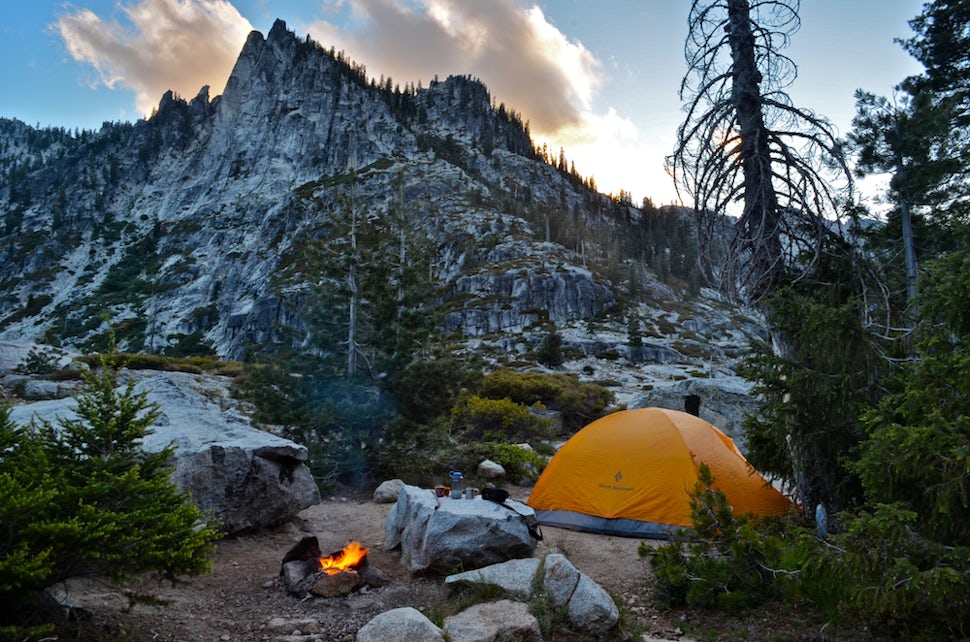What Foods Should You Eat While Backpacking?
Eating right will help you hike further and feel better.
By: NOLS + Save to a List

It can be tough to know what you should eat, and how much of it, when you’re on the trail. Lucky for you, The NOLS Cookery provides a comprehensive guide to rationing and nutrition for both short and long expeditions. You’ll also find a pile of delicious recipes for cooking gourmet food on the trail (check out the burrito recipe below!). One of the guidelines we use for food planning is the Backcountry Nutrition Pinnacle, basically a food pyramid for planning your meals.
Take a look below to see how NOLS breaks down backcountry nutrition from what you should be eating the most of to the least:
1. Water
Water forms the base of what you should be consuming with relation to how much activity you’re doing. Water is the most important nutrient for both survival and optimal nutrition in the backcountry. For a typical day of backpacking, we recommend drinking a 1/2 liter of water for every hour of moderately strenuous activity in moderately hot weather. Other liquids like tea or drink mixes are good options to supplement plain water, too. Fluids containing electrolytes, such as sodium and chloride, can help in avoiding the rare but dangerous problems related to over-hydration (see Hydration Tips for Camping).
Examples: tea, drink mixes, hot cocoa, soups
2. Starchy Vegetables and Grains
You need one to three servings at meals, and probably more on days when you’re more active. A combination of whole and processed grains and starchy vegetables is an appropriate nutritional base for high levels of physical activity. These foods are also great for the end of a long day on the trail because they tend to be quick and easy to prepare in the backcountry. This food group contains carbohydrates, which are most easily converted to energy and are your brain’s preferred fuel source; B vitamins and iron, which are essential for energy production and a healthy nervous system; and vegetable proteins that combine with beans, nuts, and seeds to make the complete proteins necessary for building and repairing body cells.
Examples: rice, pasta, potatoes, popcorn, cornmeal
The 5 Best Backcountry Recipes I Learned on my NOLS Trip | Photo: Liz Schulz
3. Vegetables, Fruit, Nuts, Seeds, and Beans
These foods are sources of carbohydrates, fiber, and vitamins and minerals and though vegetables can be tough in the backcountry, you should eat around five to eight servings per day. These foods also contain protein and healthy fats that you need as an energy source and a way to absorb some vitamins and minerals.
Examples: dried or fresh fruit and vegetables, garlic, peanut butter, veggie burger mix, chili mix
4. Poultry, Meat, Eggs, Fish, and Dairy
These foods are sources of calcium and animal protein, and you only need one to two servings per day. Calcium is important for the structure of bones and teeth as well as muscle contraction. You may use animal proteins to supplement your backcountry ration, but you don’t need them in large amounts, or even every day, to meet your nutritional needs.
Examples: powdered milk (cow or soy), cocoa, cheese, summer sausage, powdered eggs
The 5 Best Sweet Recipes I Learned on my NOLS Trip | Photo: Charlotte Klein
5. Fats and Sweets
You really don’t need much of this food type. The fats that appear in this group come from sources like butter or summer sausage. They’re different, however, than fats you’ll find in other groups, such as the essential fats in fish and nuts, or the fats in dairy that are accompanied by other important nutrients (like B vitamins). In the backcountry, we use the carbohydrates in sweet foods and the added calories from fat to support our high activity level, which is why we still need them in small portions.
Plus, fats and sweets make food tastier, which can be an important boost for your psychological health, which is equally as important as your physical health in getting you through the difficult days on the trail. Adding some brown sugar to your oatmeal can really boost your spirits in the morning when you have a long day of hiking ahead of you.
Examples: vegetable oil, margarine, candy, sauce mixes, cocoa, summer sausage, chocolate
If you want to learn more about backcountry nutrition, look for the NOLS Cookery and Backcountry Nutrition online.
Here’s a recipe for backcountry tortillas and burritos to get you energized for your next adventure:
This article was originally written by Molly Herber for the NOLS blog.
Cover photo: Dan Loch
We want to acknowledge and thank the past, present, and future generations of all Native Nations and Indigenous Peoples whose ancestral lands we travel, explore, and play on. Always practice Leave No Trace ethics on your adventures and follow local regulations. Please explore responsibly!
Do you love the outdoors?
Yep, us too. That's why we send you the best local adventures, stories, and expert advice, right to your inbox.









